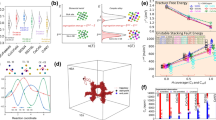Abstract
Hydrogen is a promising clean energy source, but its safe storage is challenging, as hydrogen has severe embrittling effects on metals. The extent of hydrogen embrittlement depends on the local hydrogen concentration and how it couples with the thermal and structural counterparts. This work presents a framework for hydrogen diffusion and embrittlement effects considering underlying microstructure. A hydrogen diffusion simulation is conducted on a microstructure with grain boundary trap** effect and trap** site saturation effect explicitly considered. The simulation provides a time history of hydrogen concentration in the microstructure. The grain boundary decohesion and softening effects of hydrogen are described phenomenologically by a nonuniform initial slip resistance degradation, which is computed based on the hydrogen concentration profile. This initial distribution is then used in crystal plasticity simulations to predict how the hydrogen exposure affects the mechanical properties such as initial yield stress and subsequent flow behavior. The results show that the diffusion model can capture the trap** effects of hydrogen as well as the gradual saturation of trap** sites with increased hydrogen concentration. The phenomenological model for hydrogen-based slip resistance degradation is able to capture the increased softening with longer hydrogen exposure times. The current framework provides a simple yet effective framework to connect microstructure-informed diffusion simulation with crystal plasticity to quantitatively study hydrogen embrittlement.
Access this chapter
Tax calculation will be finalised at checkout
Purchases are for personal use only
Similar content being viewed by others
References
Singla MK, Nijhawan P, Oberoi AS (2021) Hydrogen fuel and fuel cell technology for cleaner future: a review. Environ Sci Pollut Res 28:15607–15626
White C, Steeper R, Lutz A (2006) The hydrogen-fueled internal combustion engine: a technical review. Int J Hydrog Energy 31(10):1292–1305
Peschka W (2012) Liquid hydrogen: fuel of the future. Springer
Vinogradov A, Ishida T, Kitagawa K, Kopylov V (2005) Effect of strain path on structure and mechanical behavior of ultra-fine grain Cu-Cr alloy produced by equal-channel angular pressing. Acta Mater 53(8):2181–2192
Depover T, Escobar DP, Wallaert E, Zermout Z, Verbeken K (2014) Effect of hydrogen charging on the mechanical properties of advanced high strength steels. Int J Hydrog Energy 39(9):4647–4656
Fernández-Sousa R, Betegón C, Martínez-Pañeda E (2020) Analysis of the influence of microstructural traps on hydrogen assisted fatigue. Acta Mater 199:253–263
Drexler A, Bergmann C, Manke G, Kokotin V, Mraczek K, Pohl M, Ecker W (2021) On the local evaluation of the hydrogen susceptibility of cold-formed and heat treated advanced high strength steel (ahss) sheets. Mater Sci Eng A 800:140276
Song EJ, Suh D-W, Bhadeshia H (2013) Theory for hydrogen desorption in ferritic steel. Comput Mater Sci 79:36–44
Darken LS, Smith RP (1949) Behavior of hydrogen in steel during and after immersion in acid. Corrosion 5(1):1–16
Hassan Hu, Govind K, Hartmaier A (2019) Micromechanical modelling of coupled crystal plasticity and hydrogen diffusion. Philos Mag 99(1):92–115
Ogosi E, Siddiq A, Asim UB, Kartal ME (2020) Crystal plasticity based study to understand the interaction of hydrogen, defects and loading in austenitic stainless-steel single crystals. Int J Hydrog Energy 45(56):32632–32647
Yuan S, Zhu Y, Huang M, Liang S, Li Z (2020) Dislocation-density based crystal plasticity model with hydrogen-enhanced localized plasticity in polycrystalline face-centered cubic metals. Mech Mater 148:103472
Hurley C, Martin F, Marchetti L, Chêne J, Blanc C, Andrieu E (2016) Role of grain boundaries in the diffusion of hydrogen in nickel base alloy 600: study coupling thermal desorption mass spectroscopy with numerical simulation. Int J Hydrog Energy 41(38):17145–17153
McNabb A, Foster P (1963) A new analysis of diffusion of hydrogen in iron and ferritic steels. Trans Metall Soc AIME 227(3):618
Reina C, Conti S (2014) Kinematic description of crystal plasticity in the finite kinematic framework: a micromechanical understanding of f= fefp. J Mech Phys Solids 67:40–61
Clayton JD (2010) Nonlinear mechanics of crystals, vol 177
Bronkhorst CA, Kalidindi S, Anand L (1992) Polycrystalline plasticity and the evolution of crystallographic texture in fcc metals. Philos Trans R Soc Lond Ser A: Phys Eng Sci 341(1662):443–477
Herriott C, Li X, Kouraytem N, Tari V, Tan W, Anglin B, Rollett AD, Spear AD (2019) A multi-scale, multi-physics modeling framework to predict spatial variation of properties in additive-manufactured metals. Modell Simul Mater Sci Eng 27(2):025009
Zhang Y, He J (2023) Additive manufacturing material behavior prediction-a simulation based icme approach. In: AIAA SCITECH 2023 forum, p 2080
Esmaeili F, Zehsaz M, Chakherlou T, Barzegar S (2015) Fatigue life estimation of double lap simple bolted and hybrid (bolted/bonded) joints using several multiaxial fatigue criteria. Mater & Des 67:583–595
Author information
Authors and Affiliations
Corresponding author
Editor information
Editors and Affiliations
Rights and permissions
Copyright information
© 2024 The Minerals, Metals & Materials Society
About this paper
Cite this paper
He, J., Neogi, A., Pal, D., Najafi, A., Bhashyam, G. (2024). Capturing Hydrogen Embrittlement Effects with Hydrogen Diffusion Simulation and Crystal Plasticity. In: TMS 2024 153rd Annual Meeting & Exhibition Supplemental Proceedings. TMS 2024. The Minerals, Metals & Materials Series. Springer, Cham. https://doi.org/10.1007/978-3-031-50349-8_72
Download citation
DOI: https://doi.org/10.1007/978-3-031-50349-8_72
Published:
Publisher Name: Springer, Cham
Print ISBN: 978-3-031-50348-1
Online ISBN: 978-3-031-50349-8
eBook Packages: Chemistry and Materials ScienceChemistry and Material Science (R0)




